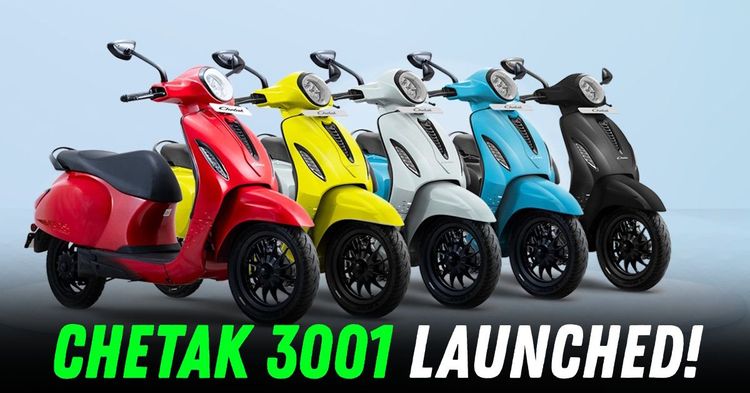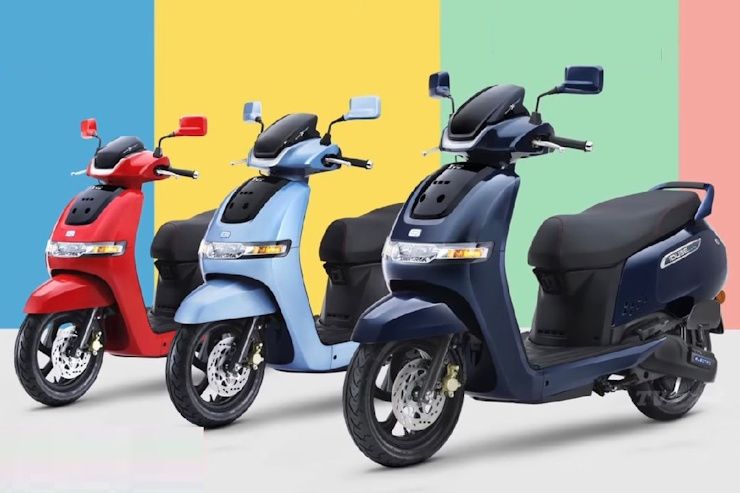Chetak 3001 Launched At Rs. 99,990: Bajaj’s Most Affordable Electric Scooter


In a move that appears to be aimed squarely at the volume segment of the electric scooter market, Bajaj has launched its most budget-friendly variant of the Chetak lineup, the Chetak 3001. With a starting price tag of ₹99,990 (ex-showroom, Bengaluru), it is positioned as an entry point into the heritage-inspired Chetak family, but without the premium bells and whistles that have so far defined the nameplate.

This latest Chetak may carry the classic metal-bodied silhouette and brand nostalgia, but it seems to be taking a more pragmatic route in terms of features, range, and positioning. The goal? Tap into buyers who are on the fence about EVs or who have been turned away by the rising prices of rivals like the Ather 450S, Ola S1 X+, and TVS iQube.
The Chetak 3001 is essentially a pared-down version of its more premium siblings. It features a 2.88 kWh battery with an IDC-certified range of 123 km and a top speed of 73 kmph. While this places it below the mid-range Ola and TVS electric scooters in terms of outright numbers, Bajaj appears to be banking on brand trust, conservative styling, and perceived long-term durability.

It uses a steel frame and retains Bajaj’s focus on robust build quality. What’s missing are many of the connected features and tech conveniences that buyers have come to expect at this price point. For instance, there’s no touchscreen, no app-based connectivity, and no fast charging. Even the display is a basic LCD unit. Bajaj, however, has added three new colour options to this version, perhaps to give the otherwise modest package some visual flair.
The Chetak brand revival began as a premium electric offering. However, the market has changed rapidly. Brands like Ola and TVS have flooded the space with multiple variants, aggressive pricing, and expansive marketing campaigns. Bajaj, despite having one of the most recognisable two-wheeler badges in India, hasn’t been able to match their sales volumes.
Part of the issue has been pricing. The older Chetak variants have largely played in the ₹1.15 to ₹1.35 lakh range, which puts them in direct competition with high-tech, higher-spec rivals. With the 3001, Bajaj is clearly hoping to unlock a new price segment that appeals to daily commuters and budget-conscious families, many of whom are now actively considering an EV for intra-city use.
The timing also aligns with the end of the FAME II subsidy regime. With central incentives drying up, a sub-₹1 lakh electric scooter becomes even more valuable. It allows Bajaj to present a relatively premium product at a price point that does not look inflated in the post-subsidy environment.

Despite the aggressive price, the Chetak 3001 might find it hard to sway buyers who now expect more than just brand trust. Ola’s S1 X+ offers better performance figures and more tech for just a marginally higher price. TVS iQube, too, packs in a better balance of range and connectivity.
The lack of fast charging or swappable battery options could also limit the appeal of the 3001 to only short-range city users. In a market where customers are increasingly comparing EVs with petrol scooters on range and refuelling (or recharging) convenience, the Chetak 3001’s limited features could be a deal-breaker for some.
Moreover, the base variant also uses a simpler swingarm and wheel assembly compared to the Premium version, which could potentially affect ride comfort or handling over longer commutes or rougher roads.
The Chetak 3001 might not be revolutionary, but it marks an important strategic shift for Bajaj. It shows the company’s willingness to broaden its reach and embrace volume-driven EV sales. The brand will now have to back this move with greater visibility, quicker expansion of its EV service network, and better dealership engagement.
Ultimately, the 3001 could become the scooter that gets more fence-sitters into showrooms, especially those drawn by the legacy of the Chetak name. But whether it can take on newer, tech-laden competitors in the long run will depend on how Bajaj balances pricing with evolving user expectations. For now, it’s a promising entry that fills a much-needed gap in Bajaj’s electric two-wheeler strategy.